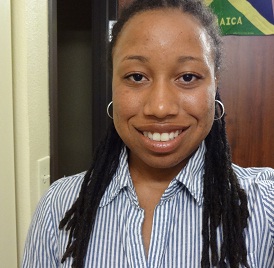

WELCOME!!!
I created this website to exhibit my experiences while partaking in the DREU Program. The acronym stands for Distributed Research Experience for Undergraduates. I participated during this summer, 2012, at the University of North Texas , in Denton, Texas. I conducted all of my reseach under the guidance of Dr. Gayatri Mehta.
About Me
 My name is Candace Calhoun.and I am originally from the D.C. Metropolitan area. I moved from Maryland to Connecticut and then relocated to Charlotte, North Carolina. While in Charlotte I started to attend Johnson C Smith University . Today I am now a Senior and plan to graduate, with a Bachelor of Sciences, in Fall 2012.
Although, I was majoring in Computer Engineering I changed my major to Information Systems Engineering. At school I am involved and a lot of extra curricular activities such as The National Society of Black Engineers(NSBE) and STARS Alliance. Furthermore, I am apart of two Honors Society's: Beta Kappa Chi National Scientific Honors Society and Sigma Tau Delta International English Honor Society.
My name is Candace Calhoun.and I am originally from the D.C. Metropolitan area. I moved from Maryland to Connecticut and then relocated to Charlotte, North Carolina. While in Charlotte I started to attend Johnson C Smith University . Today I am now a Senior and plan to graduate, with a Bachelor of Sciences, in Fall 2012.
Although, I was majoring in Computer Engineering I changed my major to Information Systems Engineering. At school I am involved and a lot of extra curricular activities such as The National Society of Black Engineers(NSBE) and STARS Alliance. Furthermore, I am apart of two Honors Society's: Beta Kappa Chi National Scientific Honors Society and Sigma Tau Delta International English Honor Society.
Mentor
 Dr. Gayatri Mehta is an Assistant Professor in the department of Electrical Engineering at the University of North Texas. She received her Ph.D in Electrical and Computer Engineering from the University of Pittsburgh in 2009. Her research interests are broadly in the areas of reconfigurable computing, low-power VLSI design, system-on-a chip design, electronic design automation, embedded systems, portable/wearable computing, and energy harvesting. If you would like to know more about her research you can click on the link above.
Dr. Gayatri Mehta is an Assistant Professor in the department of Electrical Engineering at the University of North Texas. She received her Ph.D in Electrical and Computer Engineering from the University of Pittsburgh in 2009. Her research interests are broadly in the areas of reconfigurable computing, low-power VLSI design, system-on-a chip design, electronic design automation, embedded systems, portable/wearable computing, and energy harvesting. If you would like to know more about her research you can click on the link above.
Research

The work of research that I have been taking part of will be on Coarse-grained re-configurable architecture (CGRA). CGRAs consist of an array of a large number of processing elements(PE).Coarse-grained reconfigurable fabrics have great promise for achieving energy-efficient flexible designs for an application domain. In order to use these fabrics for practical applications, however, there is a great need to develop smart mapping algorithms to implement applications of interest onto these fabrics. This research is focused on discovering new mapping strategies for customized coarse-grained devices through crowd sourcing.
The main thrust of this research is to develop a science game to discover better mapping algorithms by making use of human intuition and ability to recognize patterns and opportunities even in complex problems. Players are presented with successively more difficult mapping problems in a game environment, and the vast dataset of players' moves is analyzed to recognize common patterns used by successful game players. The insights gained from strategic moves humans make while solving problems based on their visual intuition and experience can be used to discover new mapping approaches that are beyond what can be conceived with traditional algorithms. New energy-efficient architectures and mapping algorithms that are developed in this research will spur development of a broad range of portable/wearable computing applications critical to health, safety and security, personal multimedia, and aerospace.
Click here to view my Final Report!
Journal
Week 1: June 2nd-June 9th

When I arrived in Dallas, Texas on June 2nd the first thing I thought was "it is too HOT!". This was my first time ever in the state of TX, so coming from he East Coast this was a big change for me. After I got my suitcases situated I caught a cab out to the city of Denton and viewed the huge campus of UNT. I stayed on campus, in Legends Hall, with the rest of the DREU and various other students. My first day in the CAD Lab was June 4th. The lab is not on the main campus, it is located in Discovery Park so we had to catch the shuttle there. Once the other students and I got there we parted ways to meet with our individual professors/mentors. Dr. Mehta introduced me to the rest of the team that I would be working with on the project. For the entire first week I was in the lab playing the game "Untangled"that they have been developing for the past year. The reason being because she wanted my feedback on what else they could do to improve upon. I documented my strategies for how to beat levels in the game. On the other hand the whole team worked together to improve the tutorials to allow new players to better understand the game.
Week 2: June 11th-June 15th

This week I received two research papers to read over from my mentor. While reading I absorbed more knowledge about different architectures.In addition to that I teamed up with our graduate researcher, Krunal, to fix bugs(errors) within the game.I played the game to try and create a new tool for players to use in the game. Unfortunately, my theory would not work for three of the game types: Stripe, 4Way, and DR. I also was assigned with my research partner, Natalie, to evaluate the teams graphs and see what they all had in common.
Week 3: June 18th-June 22nd
This week I have been given the task to start analyzing the graphs in each level of the game. I examined the top three graphs and kept record of them. I had to put together visuals and print them out and also kept spread sheets of all of my data. My goal here was to find out why the those graphs made it to be the top 3. Furthermore, I played the game but this time I was forced to use the constraints to see if I was still able to beat the algorithm. The final outcome using a ratio of 4:1 in majority of the levels I was able to beat with smaller size graphs, which was great!
Week 4: June 24th-June 29th
This week since we had new players recruited from outside of our research group playing the game, I had to redo all of the visuals with the new updated graphs. I made notes of all of the new records and updated my spreadsheets also.
Week 5: July 2th-July 6th
I was assigned the task to compare old graphs from june and make different spread sheets exploring how many nodes the graph was composed of. In addition to that seeing how many pass gates were put in the graph and why. Out of a total of 42 games to scrutinized you can say I had my work cut out for me.
Week 6: July 9th-July 13th
My job was to compare graphs july 6th to graphs on july 9th and July 10th to July 12th. I was to examine the height and width and see if the nodes were moved to a different place on the grid.I did this to every player that moved up on the leader boards. Later in the week i was aasked to change p the spreadsheets by not just having the names of the top three leaders but adding scores, sizes, and pass gates also. Moreover I got interviewed by UNT's publications worker Angela for my work in the project.
Week 7: July 16th-July 20th
This week I continued updating my data for each day and also was assigned the task of completing an analysis. I had to analyzed the bottom three graphs and top three graphs basically seeing what was the difference between the bottom and top graphs. Why each was placed that way on the leaderboard whether the reason being they all used different techniques or how they placed their nodes on the grid(connectivity). I had to figure out the common factor and averaged out all the scores. In addition to this work I also had to pick out pictures to be placed on the Research poster, The Evolution.
Week 8: July 22nd-June 27th
This is my final week here in Texas and my last assignment was to do two last analysis on routing algorithms for the sub levels 4Way-1Hop and 4Way-2Hops. I observed the spread sheets that Natalie worked on the week before to see if any of the nine trials were better than the original algorithm. Other than that this week was mainly used to work on our research papers nd put the finishing touches on our websites and and compile all the work I have done into one folder to be sent to Dr. Mehta along with a readme file.